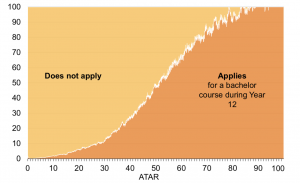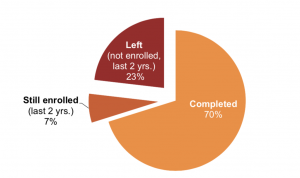The cost of applying to University, especially if a student drops out, can be significant. The article (see the link below) outlines the positives and perils, of dropping out of University. In 2018 about 50,000 students dropped out of University, and this stat has been constant since. Currently in 2022 they suggest about 30% of first years are moving and changing courses and about 20% of students drop out all together. This is the size of the UNSW student population. It is probably no surprise that students studying part time are most likely to drop out, especially as they are usually in paid work and have family commitments.

ATAR’s are also another indicator of dropout rates. ATAR’s below 60 are a bigger predictor of dropping out, and ATAR’s over 90 are a strong predictor of completing a degree. This chart is taken from the Grattan Institute report checking out a leaving class from a few years back now but tracking how they went and noting the higher ATAR’s equate to a more likely completion. You don’t have to be a rocket scientist to figure that out, but it doesn’t necessarily mean that high ATAR smarts, equal success. It more likely means the intellectual aptitude of the Uni student is able to keep up with the academic levels of the course they have chosen.

This (evidence based) article outlines that dropping out of University is not as bad as it sounds. Students have a minimal debt, they can acquire some skills, but most importantly realise that the course, or place is not for them and so continue on with their career path. South Australian students from this survey were found to have only 60% certainty in their first tertiary preference. Concluding that it is totally normal to feel confused about University places, and choices. This is part of the whole process.

We see in this chart again in the Grattan report that only 70% of students who first enrol complete their degree’s. That is a lot that go on, not to complete, or continually plan on completion. I know many students who have started but don’t finish, which can add up to a large student debt.
Each year, students attempt to go to University – because their friends are going, or because it is the expected path, but actually a more practical applied course would be more suitable for them. These students are usually the ones who will only last a semester.
They then realise a more academic style of learning is too challenging for them, or does not suit their learning style. Once they move into a practical environment, such as TAFE or a vocational college, they thrive and set themselves up for success.
To read more, click here on the Grattan report investigating drop out rates. Also some very interesting data here on the background reasons why students drop out.
This article looks at trade based qualifications and University based and measures up the data from 2022.
